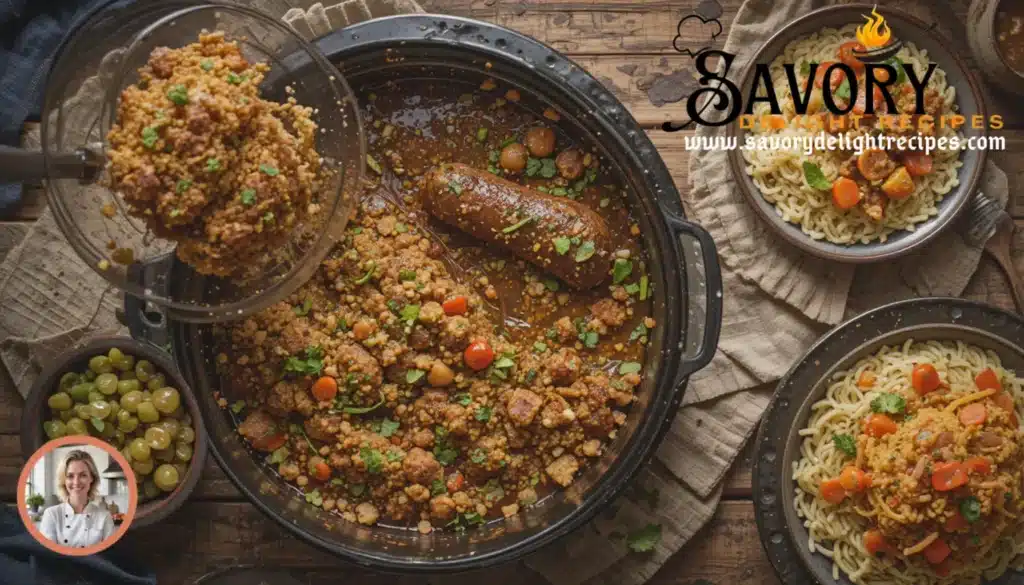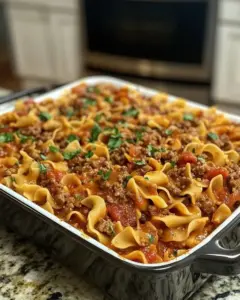Last Updated on 09/06/2025 by SAVORY DELIGHT RECIPES LLC
Americans spend an average of 37 minutes cooking dinner each night. This adds up to more than 225 hours yearly at the stove!
The solution lies in crockpot meals that need just 15 minutes of prep time. You can add ingredients before leaving and come back to a perfectly cooked dinner. Busy professionals and parents rely on these easy crockpot recipes. Anyone who wants tasty home-cooked meals without the fuss will love them too.
These simple crockpot meals make cooking stress-free. You could be new to slow cooking or just want to try more recipes. The slow cooking method actually enhances the flavors of your dishes naturally.
Your weeknight dinner routine needs a makeover. Let’s dive into 5 simple steps that will help you create delicious crockpot meals easily.
Choose Your Crockpot Size and Settings
A significant part of creating successful meals is picking the right crockpot. Let’s explore the perfect size and settings that match your cooking needs.
Understanding Different Crockpot Sizes
Your household’s size determines which crockpot will work best for you. The crockpot should be filled between one-half and two-thirds full to achieve optimal results. Here’s a practical size guide:
| Household Size | Recommended Crockpot Size |
|---|---|
| 1-2 people | 3-4 quarts |
| 3-4 people | 5-6 quarts |
| 5+ people | 7-8 quarts |
Most households find a 6-quart model the most versatile choice that fits standard recipes and leaves room for leftovers.
Temperature Settings Guide
Today’s crockpots come with three main temperature settings that help you create perfect meals:
- Low Setting: Maintains temperatures between 170-200°F, reaching 205°F after 4 hours
- High Setting: Reaches temperatures up to 280°F, perfect for faster cooking
- Warm Setting: Maintains food at serving temperature (165-175°F)
The low setting takes twice as long to cook compared to the high setting. This gives you the flexibility to adapt meals to your schedule.
Essential Features to Consider
Your crockpot’s features are a great way to get more from simple meals. Look for:
- Programmable Timer: Switches to warm setting automatically after cooking
- Temperature Probe: Monitors food’s internal temperature precisely
- Removable Insert: Enables easier cleaning and stovetop browning
- Locking Lid: Perfect for transporting meals
An oval-shaped model works best if you cook whole chickens or large meat cuts often. This shape distributes space better and cooks more evenly.
Plan Your Weekly Meal Schedule
Smart planning is the secret to successful crockpot cooking. A single hour spent on meal planning helps you streamline groceries and stick to healthy eating habits all week.
Creating a Balanced Meal Plan
Your weekly schedule works best with 2-3 crockpot meals. Most recipes feed a family of four, but you can adjust portions based on your family’s size.
A themed weekly menu might look like this:
- Monday: Comfort Foods
- Tuesday: Healthy Soups
- Wednesday: International Flavors
- Thursday: Protein-focused
- Friday: Family Favorites
Shopping List Organization
Your grocery trips will be quicker when you organize the shopping list by food categories. Here are the basics you’ll need:
- Stock and broths for base liquids
- Dried herbs and seasonings
- Canned tomatoes and sauces
The slow cooker turns less expensive cuts of meat tender and delicious. You can stretch your budget by adding beans, pulses, and seasonal vegetables to your meals.
Prep-Ahead Strategies
A smooth morning assembly needs these prep tasks done the night before:
- Trim meats
- Chop vegetables
- Measure dry ingredients
- Prepare sauces
Batch prepping ingredients for multiple meals at once is the quickest way to save time. Each prepped component needs its own container until cooking time – this keeps food safe and fresh.
Time-Saving Tip: The crockpot insert with assembled ingredients can go in your fridge overnight. Just pop it into the base next morning and start cooking.
Note that perishable foods should stay refrigerated until prep time, and meat must be completely thawed before it goes in the crockpot. Fill your crockpot between half and two-thirds full to reach the right cooking temperature.
These planning strategies will revolutionize how you use your crockpot. Quick meals become reliable parts of your weekly routine. Start with a few simple recipes and add more as you get comfortable with the process.
Master the Layering Technique
The secret to making delicious crockpot meals lies in proper ingredient layering. This technique helps food cook evenly and keeps its texture just right. Your crockpot works like a stage where each ingredient needs the right spot at the right time.
Order of Ingredients
Heat is most intense at the bottom of your crockpot, so ingredients need strategic placement. Your easy crockpot recipes will turn out better if you layer them this way:
- Bottom Layer: Dense root vegetables (carrots, potatoes, onions)
- Middle Layer: Meat or protein
- Top Layer: Delicate vegetables and aromatics
- Final Layer: Fresh herbs or citrus slices
Optimal Food Placement
The best results come when your crockpot is filled between two-thirds and three-quarters full. Root vegetables should sit against the sides and bottom of the crock where they’ll get direct heat. This setup will give a perfectly cooked meal and prevents uneven results in your quick crockpot dishes.
Here are some helpful tips for meat-based dishes:
- Trim excess fat before adding meat to the middle layer
- Cut ingredients into uniform sizes to cook evenly
- You might want to pre-brown meat to boost flavor (optional but recommended)
Liquid Ratios Guide
Liquid management is a vital part of simple crockpot meals. Crockpots keep moisture in, so they need less liquid than traditional cooking methods. Here’s how to get your liquid ratios right:
Your liquid shouldn’t cover more than half of your ingredients. Most recipes work well with just ½ to 1 cup of liquid. If you’re converting a standard recipe to use in your crockpot, cut the liquid by about one-third.
Important: Add enough liquid to create steam when cooking meat, but don’t submerge the ingredients. The meat will release its juices as it cooks. You can thicken a too-thin sauce by:
- Taking the lid off during the final cooking hour
- Adding a cornstarch slurry
- Rolling meat in seasoned flour before cooking
Note that uneven cooking usually happens because of poor layering. These layering techniques will help you become skilled at making perfectly cooked, flavorful crockpot meals consistently.
Perfect Your Timing and Temperature
The perfect easy crockpot meals depend on your understanding of timing and temperature. You’ll become skilled at slow cooking and avoid common mistakes with the right knowledge.
Cooking Duration Guidelines
Temperature settings determine your cooking time. Different crockpots reach their simmer point (209°F) at these intervals:
- Low setting: 7-8 hours to reach simmer point
- High setting: 3-4 hours to reach simmer point
This quick reference guide shows timing for common ingredients:
| Food Type | Low Setting | High Setting |
|---|---|---|
| Large Pork Roast (6-7 lbs) | 9:30 hours | <citation index=”24″ link=”https://help.crock-pot.com/s/article/CPCookingChart” similar_text=”Slow Cooking Chart |
| Beef Roast (3-4 lbs) | 8:30 hours | <citation index=”24″ link=”https://help.crock-pot.com/s/article/CPCookingChart” similar_text=”Slow Cooking Chart |
| Poultry (6 lbs) | 7:30 hours | <citation index=”24″ link=”https://help.crock-pot.com/s/article/CPCookingChart” similar_text=”Slow Cooking Chart |
| Fish (2 lbs) | 2:30 hours | <citation index=”24″ link=”https://help.crock-pot.com/s/article/CPCookingChart” similar_text=”Slow Cooking Chart |
Temperature Adjustments
Your crockpot’s temperature settings work for different needs:
- Low (190°F): Creates tender results during all-day cooking
- High (300°F): Works best when you need faster cooking
High-altitude cooking needs an extra 30 minutes for each hour in your recipe. Elevated areas substantially affect cooking times, so adjust your timing to get perfect crockpot meals.
Converting Regular Recipes
You can turn regular recipes into easy crockpot versions with this simple formula: one hour of traditional cooking at 350°F equals 8-10 hours on low or 4-6 hours on high. Here are the essential points to remember:
Important Temperature Indicators:
- Food becomes safe at 165°F internal temperature
- You should easily shred meat when it’s done
- Chilled ingredients need extra time to heat up
Quick crockpot meals need 40-50% less liquid than the original recipe. The lid keeps moisture trapped inside, so you’ll need less liquid than traditional cooking methods.
Pro Tip: Your meal stays safe to eat up to two hours after cooking if the temperature remains above 140°F. An instant-read thermometer helps verify safe temperatures.
Your meat’s fat content, liquid amount, and vegetable size will affect cooking duration. Watch your first attempt with any new recipe closely to get perfect timing for your specific crockpot and ingredients.
Enhance Flavors and Textures
Making delicious crockpot meals takes more than throwing ingredients together and hitting start. Let’s look at ways to boost your dishes with professional seasoning techniques and better textures.
Seasoning Tips and Tricks
The long cooking time in your slow cooker changes how seasonings develop. Dried herbs like rosemary, sage, and thyme need to go in right at the start to release their flavors fully. But you should cut back on spicy ingredients like chili powder since they get more intense during slow cooking.
To get the best flavors:
- Use twice the amount of aromatics like garlic and ginger
- Add umami boosters like Worcestershire sauce or soy sauce
- Mix in a bit of brown sugar or honey to balance flavors
Adding Fresh Ingredients
The right timing makes a big difference when you add fresh elements to your easy crockpot recipes. Fresh herbs lose their punch during long cooking, so add them just 5 minutes before finishing. Here’s the best sequence to follow:
| Ingredient Type | When to Add |
|---|---|
| Fresh Herbs | Last 5 minutes |
| Citrus Juice | Final 30 minutes |
| Fresh Vegetables | Last 15-20 minutes |
Pro Tip: You can get bright colors and better texture by blanching extra vegetables separately and adding them just before serving.
Thickening Sauces
Your crockpot’s lid keeps moisture in, which can leave you with thin sauces. Here are three professional ways to get the perfect thickness:
-
Pre-cooking Method: Coat meat with seasoned flour before it goes in the crockpot. This thickens your sauce naturally while cooking.
-
Roux Technique: Mix equal parts butter and flour, cook until thick, then whisk into your simmering sauce. Professional chefs love this method.
-
Natural Thickening: Blend some cooked vegetables or beans to thicken your sauce without extra ingredients. This keeps original flavors while improving texture.
Your sauce needs tweaking? Take the lid off for the last 30 minutes to let it reduce naturally. For recipes with dairy, add milk, cheese, or cream in the final hour so they don’t separate.
Important: Converting regular recipes to crockpot versions? Cut the liquid by about 40%. Steam gets trapped under your slow cooker’s tight seal and creates extra juice, so you won’t need all the liquid from standard recipes.
A final taste test helps perfect your seasonings. A splash of vinegar or citrus juice can wake up flavors that have mellowed during cooking. This simple step turns good crockpot meals into great ones.
Conclusion
A crockpot changes complex meal preparation into a simple, time-saving process. Your success relies on choosing the right equipment size and planning meals carefully. You need to layer ingredients properly, manage cooking times, and enhance flavors with professional techniques.
These five steps put you in control of your slow-cooking experience. Each meal tastes better as you practice these fundamentals. Weeknight dinners transform from a stressful chore into an easy win.
Your crockpot’s unique features determine the perfect meal outcome, so adjust recipes as needed. Simple recipes work best when you begin. You can experiment with seasonings and timing later. Soon you’ll create restaurant-quality dishes without much effort. Your crockpot becomes a trusted kitchen ally that helps you serve delicious, wholesome meals every day.
FAQs
Q1. How can I enhance the flavor of my crockpot meals? To enhance flavor, use dried herbs like rosemary and thyme at the start of cooking, double aromatics like garlic and ginger, and add umami boosters like Worcestershire sauce. Finish with fresh herbs in the last 5 minutes for brightness.
Q2. What are some common mistakes to avoid when using a slow cooker? Common mistakes include lifting the lid too often, using expensive cuts of meat, not searing meat first, and using the wrong size cooker. For best results, fill the cooker 1/2 to 3/4 full and use cheaper, tougher cuts of meat that benefit from slow cooking.
Q3. What types of dishes work best in a slow cooker? Slow cookers are ideal for tough cuts of meat like beef brisket, pork shoulder, and chicken thighs. They’re also great for soups, stews, chilis, and dishes that benefit from long, slow cooking to develop flavors.
Q4. How should I layer ingredients in a slow cooker for best results? Layer ingredients with denser items like root vegetables at the bottom, followed by meat in the middle, and more delicate ingredients on top. This ensures even cooking and prevents overcooking of softer ingredients.
Q5. How do I adjust liquid amounts when adapting recipes for a slow cooker? When adapting recipes for a slow cooker, reduce the liquid by about 40% compared to traditional cooking methods. The tight seal on slow cookers prevents evaporation, so less liquid is needed to achieve the desired consistency.
- One-Pan Chicken with Buttered Noodles: 3 Easy Steps - 20/07/2025
- Taco Ranch Bites: 3 Simple Steps for Flavor! - 20/07/2025
- Buffalo Chicken Pasta: 3 Secrets You Need Now! - 20/07/2025





Comments are closed.